Crafting the Perfect Coffee Cake Recipe
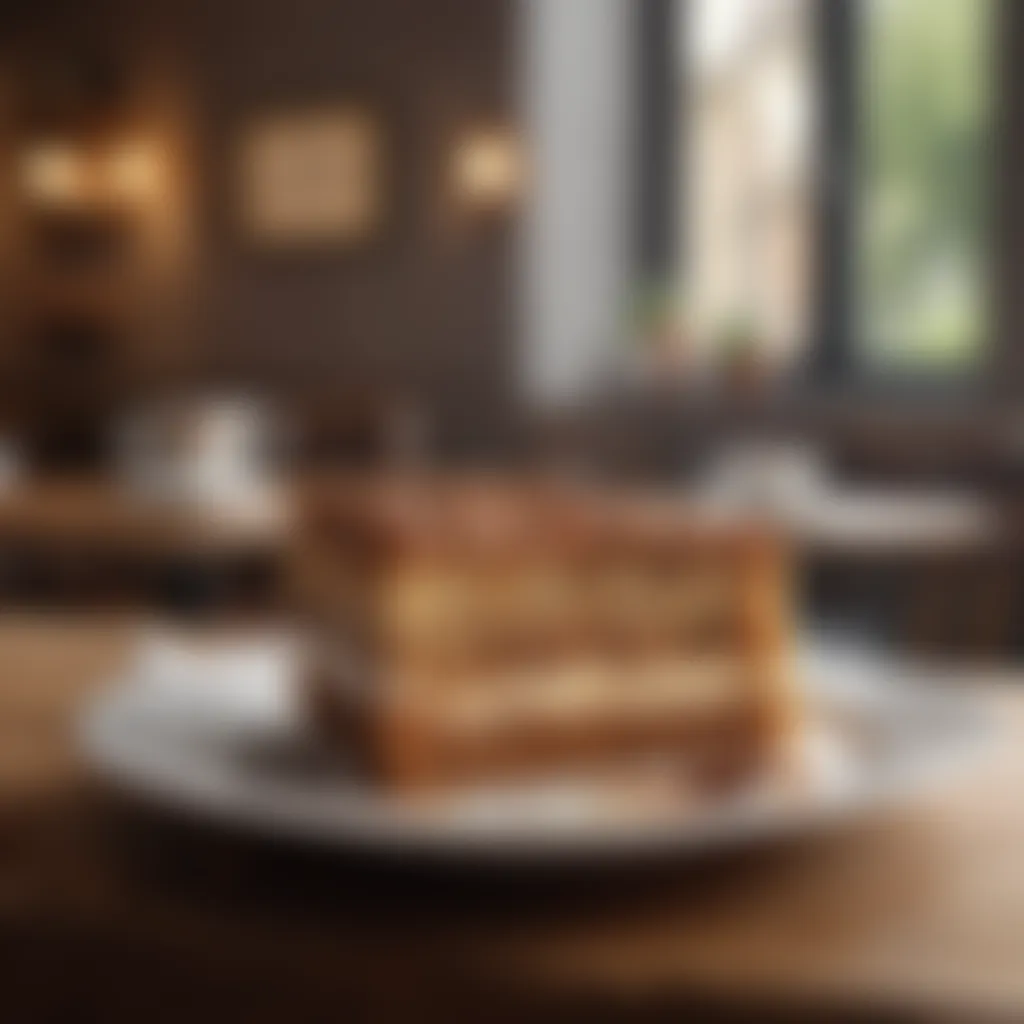
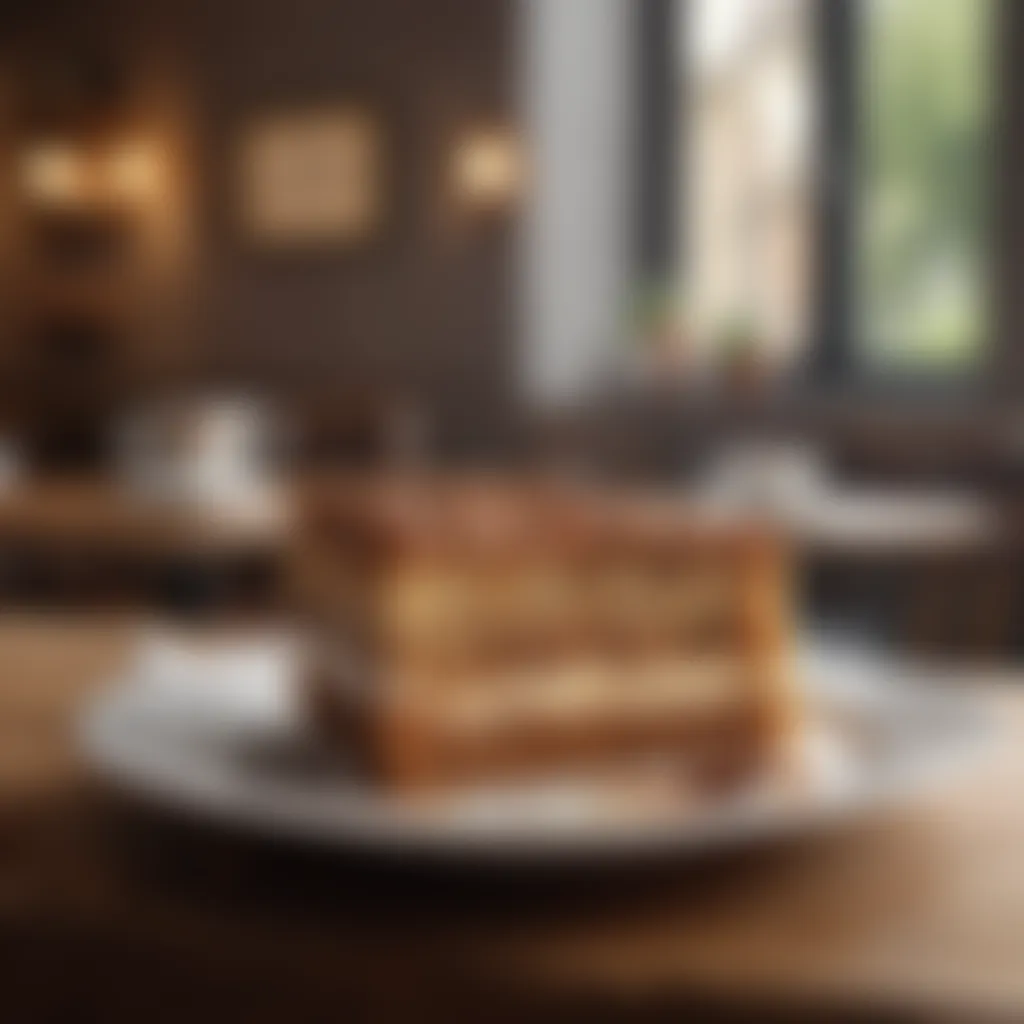
Intro
Creating a coffee cake that stands out takes more than just following a recipe. It’s about understanding the elements that make a cake not just good, but remarkable. From the first step of gathering ingredients to the final touch of presentation, every moment matters. This guide will take you through each detail, ensuring that your endeavor into coffee cake baking becomes a cherished experience.
The allure of coffee cake stems from its ability to blend flavors and textures, making it a delightful companion to a warm cup of coffee. It's a delightful dance of flavor where every ingredient plays a crucial role. So, let’s embark on this culinary journey together, step by step.
Prolusion to Coffee Cake
Coffee cake is more than just a delightful treat that pairs beautifully with a warm beverage. It embodies a sense of comfort, tradition, and culinary creativity that has captivated taste buds across generations. As we explore the depths of crafting a unique coffee cake recipe, it becomes crucial to understand the elements that form the foundation of this simple yet profound culinary creation. This exploration opens up avenues for creativity while grounding our baking in historical context and flavor profiles.
Historical Context
The origins of coffee cake can be traced back to the European tradition where cakes were often enjoyed with their morning brews. Baked primarily in the 17th century, it was presumed that the blend of cake and coffee was a match made in culinary heaven. Amongst rich German influences, the concept of coffee cakes expanded, incorporating local ingredients and baking styles. In a sense, coffee cake has transformed over centuries, reflecting cultural shifts and regional tastes. Today, it serves not just as an addition to breakfast, but is often the centerpiece of social gatherings and family brunches.
The variety of formats—from crumbly coffee cakes dotted with nuts to moist ones layered with fruits—are a testament to its versatility. Each recipe has its own story to tell; consider the classic Streuselkuchen from Germany, or the visually stunning coffee cakes from Scandinavian bake shops, often adorned with intricate toppings.
Defining Features of Coffee Cake
When we talk about coffee cake, we are referencing something specific. It's not just any cake meant to accompany coffee; it has distinguishing features that set it apart from regular cakes. The first characteristic is its moist texture, which is often attributed to the use of sour cream or yogurt in its recipe. This brings a tanginess that balances the sweetness, creating a delightful symphony on the palate.
Moreover, the absence of frosting is another defining element of coffee cake. Instead, you usually find various toppings such as streusel or a light glaze. This simplicity enhances the cake's ability to pair beautifully with coffee, allowing the flavors of both to shine through.
A pivotal feature of coffee cake is its incorporation of spices like cinnamon or nutmeg, which add warmth and depth. Similar to a kitchen-dance that mixes flavors, the combination of spices, sweetness, and rich textures creates a unique experience with every bite.
Overall, these defining traits of coffee cake not only elevate it to a status of beloved treat but also provide a great platform for experimentation and personal touch in your own baking endeavor.
Understanding Flavor Profiles
When diving into the heart of crafting an exquisite coffee cake, understanding flavor profiles is crucial. It’s not just about combining ingredients; it’s about creating a symphony of taste that dances on the palate. Each layer of flavor contributes to a richer overall experience. Knowing how different flavors interact can make or break your coffee cake creation. This section breaks down the essential elements that help to establish a delicious balance in your bake.
Balancing Sweetness and Bitterness
In the world of baking, sweetness is often perceived as a comfort. However, in coffee cake, it’s vital to strike a balance with bitterness, typically derived from coffee itself. Think of it as a tug-of-war between sugar and the natural depth found in coffee. Too much sweetness can overpower, while too much bitterness can lead to an unpalatable result.
For an ideal outcome, consider using a medium roast coffee blend. It has just enough boldness to shine through without overcoming the other flavors. Using refined sugars like granulated sugar can add upfront sweetness, while brown sugar introduces a molasses-like richness, which complements well with coffee's bitterness.
To illustrate:
- Granulated Sugar: Adds immediate sweetness, perfect for your base batter.
- Brown Sugar: Creates a more nuanced sweetness, ideal when incorporating richer flavors.
Finding that middle ground can elevate your coffee cake, making it a little less likely to 'put your teeth on edge'. Keep in mind, experimenting with the ratios can lead to delightful surprises, so don't fear a little tinkering.
Incorporating Spice Elements
Spices do a magic act in baking, enhancing and elevating the flavors present. Cinnamon and nutmeg can complement the sweetness, while cardamom offers an exotic twist, transporting your palates to far-off lands. Karla, a home baker from Ohio, swears by adding just a pinch of freshly grated nutmeg in her recipes to make the flavor pop.
Diving into spices isn't just about throwing them into the mix. The timing and method of incorporation can change the character of your cake:
- Adding Spices to the Batter: This method allows for a deep infusion of flavor as everything bakes together.
- Sprinkling on Top Before Baking: Creates a delightful aroma and an inviting appearance, giving your cake a warm finish.
To be clear, moderation is key. Spices should enhance the natural flavor of your ingredients, not smother them. A little experimentation with different spice blends can lead to discovering your signature coffee cake flavor, making your creation truly unique. With a palate as your guide, add joy to the process of baking.
Selecting Quality Ingredients
Selecting quality ingredients is half the battle when making a remarkable coffee cake. The ingredients act as the foundation of the recipe, influencing not just the flavor but also the texture and aroma of the final product. Choosing the right components ensures that you achieve the best possible results, making each bite an indulgent experience. Let’s break down the essential elements that contribute to an exquisite coffee cake.
Essential Baking Components
Flour Types
When it comes to flour, different types can significantly affect the structure and texture of your coffee cake. All-purpose flour is a common choice because it offers a nice balance between strength and tenderness. With a protein content hovering around 10-12%, it provides the gluten needed for the cake while keeping it soft and airy.
However, if you’re seeking a more delicate crumb, cake flour, with its lower protein content, is the way to go. The lack of gluten helps keep the cake moist and tender, which is especially crucial when you want a light texture.
A well-chosen flour type not only impacts the flavor but also the cake's texture.
Using whole wheat flour can lend a nutty taste and a bit of healthiness, but remember, it might make the cake denser and a touch chewier, so take that into account while adjusting other ingredients.
Sweeteners
Sweeteners are another key player in the crafting of coffee cake. While granulated sugar is the classic choice, brown sugar adds depth with its molasses flavor, resulting in a richer cake. Brown sugar provides moisture, which can result in an extra tender crumb, making it a favorite among bakers who wish to enhance flavor without adding complexity.
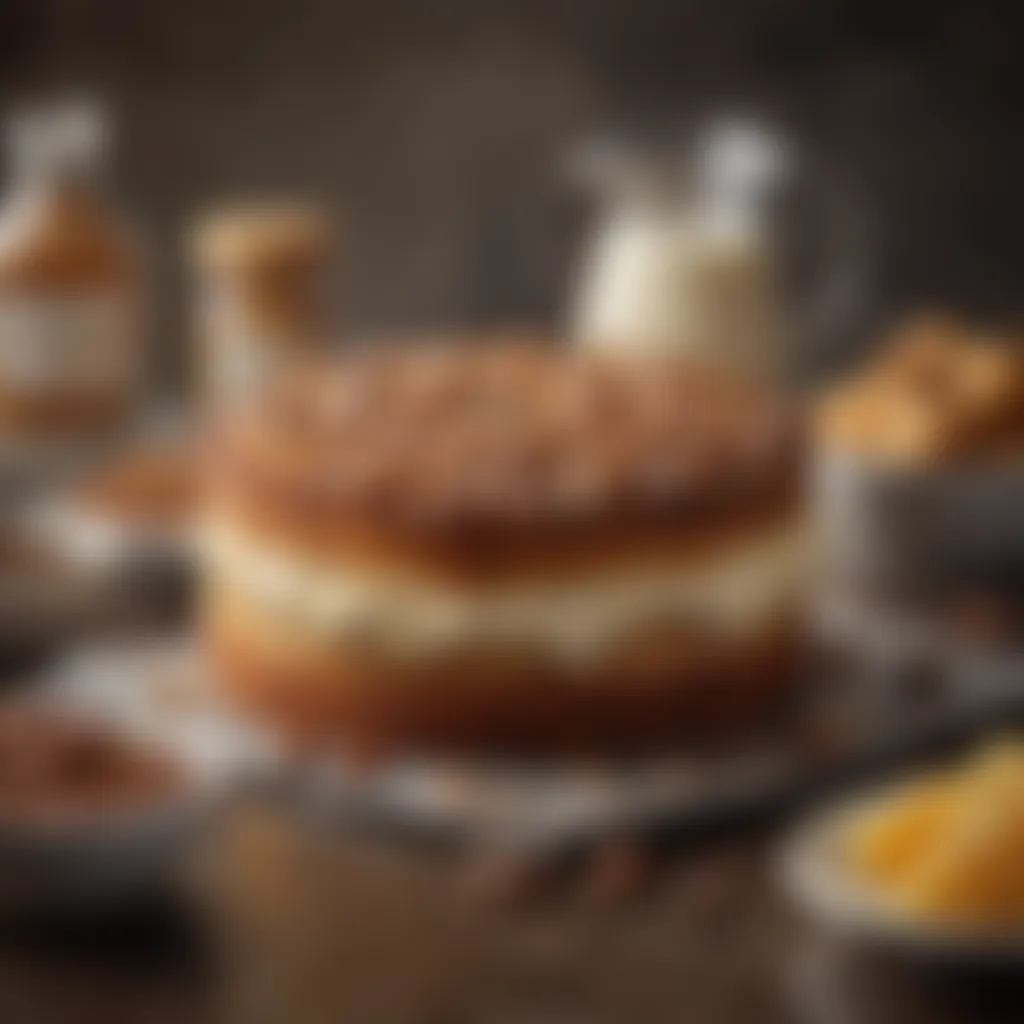
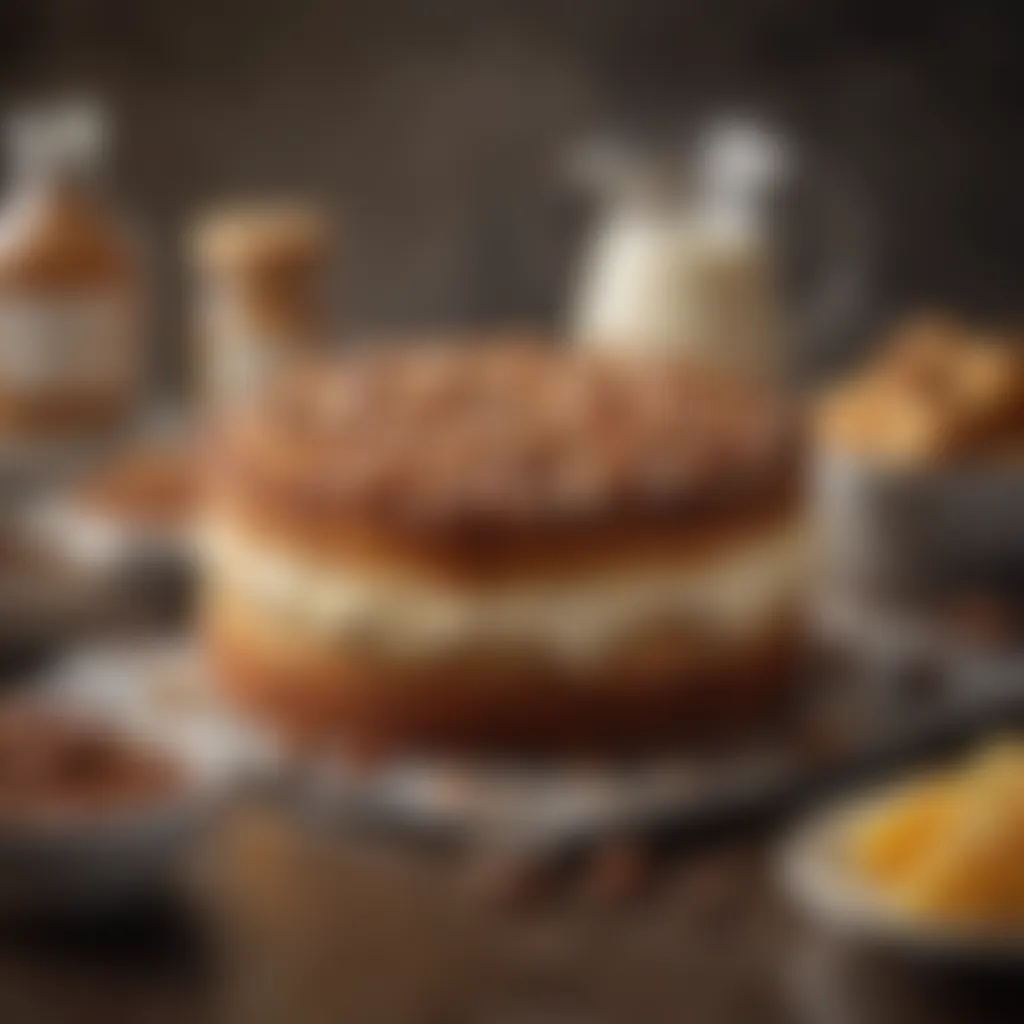
For those leaning towards natural options, honey or maple syrup can be used; however, they require adjustments in liquid components as they introduce additional moisture. Just be cautious—using too much can alter not just the taste, but the cake’s structure as well.
Fats and Oils
The type of fat you choose also plays a pivotal role. Butter is a beloved ingredient in baking, contributing not only flavor but also texture. It creates a lovely richness that enriches every bite. On the flip side, vegetable oil can make your cake moister, as it remains a liquid at room temperature, leading to an ultra-soft product.
One must note the differences: butter brings flavor while oil offers moisture. A blend might be a solution if you’re aiming for a perfect cake with flavor and softness.
Flavor Enhancements
Extracts and Zests
Extracts, like vanilla or almond, are essential to elevating the flavors of your coffee cake. A mere teaspoon can remarkably enhance the taste, providing an aromatic symphony that complements the sweetness. Zests from citrus fruits like lemon or orange bring brightness and zest to the overall flavor profile, contrasting beautifully with the sweetness of the cake.
Integrating extracts and zests is crucial for achieving a rich flavor narrative in your baking.
Using fresh zest tends to yield more vibrant flavors than dried versions. Choose wisely to ensure you steer clear of overly bitter notes that might detract from the delight.
Nuts and Fruits
Lastly, incorporating nuts and fruits can introduce an extra layer of complexity to your coffee cake. Walnuts or pecans provide a crunchy contrast to a soft cake, while fruits like blueberries, apples, or even bananas can add moisture and natural sweetness.
When selecting fruits, consider their moisture content. Overly juicy fruits can lead to a soggy cake if not managed well. It's all about balance—adding just enough to enhance texture and flavor without compromising the cake's integrity.
Crafting the Perfect Batter
Creating the perfect batter is nothing short of an art form when it comes to baking a coffee cake. This essential step lays the foundation for all the flavors and textures that follow. A well-prepared batter can mean the difference between a dry, crumbly cake and one that is moist and tender. The goal here is to achieve a delicate balance of ingredients that meld together harmoniously, which ultimately leads to a delightful culinary experience.
The importance of this stage cannot be overstated. A perfectly crafted batter ensures that the final bake rises well, maintains its structure, and delivers on flavor. This section focuses on techniques to achieve that elusive perfect batter, emphasizing the benefits of using the right mixing methods and the consequences of overmixing.
Mixing Techniques
Methods of Incorporation
When it comes to mixing techniques, understanding the methods of incorporation is key. These methods refer to how different ingredients are combined, a critical factor that significantly affects texture. The most common approach involves the creaming method, where butter and sugar are beaten together until fluffy before adding other ingredients. This approach traps air, which helps the cake rise during baking.
A notable characteristic of this method is its versatility. It can be adapted for various recipes and types of cakes. A few advantages stand out:
- It creates a lighter texture that many enjoy.
- It allows for the gradual infusion of flavor as ingredients blend together.
However, there can be pitfalls; for instance, if not done properly, the batter can become too thick or fail to rise adequately. That’s why understanding the nuances of mixing is essential. It is not just about combining ingredients; it’s about achieving a lightness that feels almost ethereal.
Avoiding Overmixing
Another critical aspect is avoiding overmixing. This is often overlooked, but it is a decisive factor in the quality of your coffee cake. Overmixing happens when you continue to stir after the dry ingredients have just come together with the wet ones.
This action can lead to a tougher texture as it develops the gluten in the flour, resulting in a dense cake rather than the fluffy delight one expects. Key considerations for avoiding overmixing include:
- Stirring just until the ingredients are combined is sufficient.
- Using a rubber spatula or wooden spoon can help mitigate the risk of overworking the batter.
The unique feature about this aspect is the balance you must maintain; while mixing is essential for a homogenous batter, restraint is equally vital. Knowing when to stop mixing is an acquired skill that greatly enhances your cake-making abilities.
Achieving the Right Consistency
Achieving the right consistency in the batter is an art in itself. The batter should be thick enough to hold its shape, yet fluid enough to pour easily into a pan. This perfect balance allows for a cake that rises beautifully but doesn’t become stale.
Visually, a well-prepared batter often has a smooth, cohesive appearance. If you find yourself with lumps, gently folding or whisking can help—just remember not to go overboard. Testing small amounts can also assist you in determining if you've reached the right consistency. Your senses will guide you—look for a batter that drips off the spatula without leaving trailing clumps.
In summary, mastering the preparation of batter requires patience and a willingness to experiment. Focusing on effective mixing techniques, strictly avoiding overmixing, and achieving the correct consistency will ensure that your coffee cake emerges from the oven as a true masterpiece.
The Role of Toppings and Fillings
In the realm of coffee cake creation, toppings and fillings are not just decorative elements; they play a pivotal role in defining the cake’s overall character and flavor profile. They provide texture, enhance visual appeal, and can elevating even the simplest cake into something noteworthy. The consideration of these components is essential for achieving a balance that delights the palate and yet speaks to the skill involved in the baking process.
Types of Toppings
Crumble Toppings
Crumble toppings are a classic feature found on many coffee cakes, and they bring a delightful crunch to the soft, moist crumb of the cake itself. Typically made with a blend of flour, sugar, and butter, these toppings are crumbled by hand before scattering them over the cake prior to baking. The key characteristic of crumble toppings lies in their texture—the contrast between the tender cake and crispy topping creates an inviting eating experience. It's a popular choice for those who favor texture over more refined finishes, making it a beneficial aspect of coffee cakes. Additionally, they can be adapted with seasonal ingredients such as nuts or spices to align with personal preferences or seasonal flavors. However, it’s vital to find the right balance; too much crumble might overwhelm the cake and make it overly rich.
Icing and Glazes
Icing and glazes lend an elegance to coffee cakes that can transform the appearance from humble to stellar. With the main ingredient typically being confectioners' sugar, these toppings offer sweetness that complements the cake’s flavors. Icing tends to be thicker, while glazes are pourable, making each option suitable for differing personal preferences. The uniqueness of icing and glazes, particularly their glossy sheen, adds to the visual allure of your coffee cake, drawing eyes to its delightful surface. They also provide a means to introduce additional flavors, like vanilla, chocolate, or even citrus zest. However, one must be cautious not to overdo it; too sweet a glaze can mask the cake's intrinsic flavors, so moderation is key to maintaining a harmonious balance.
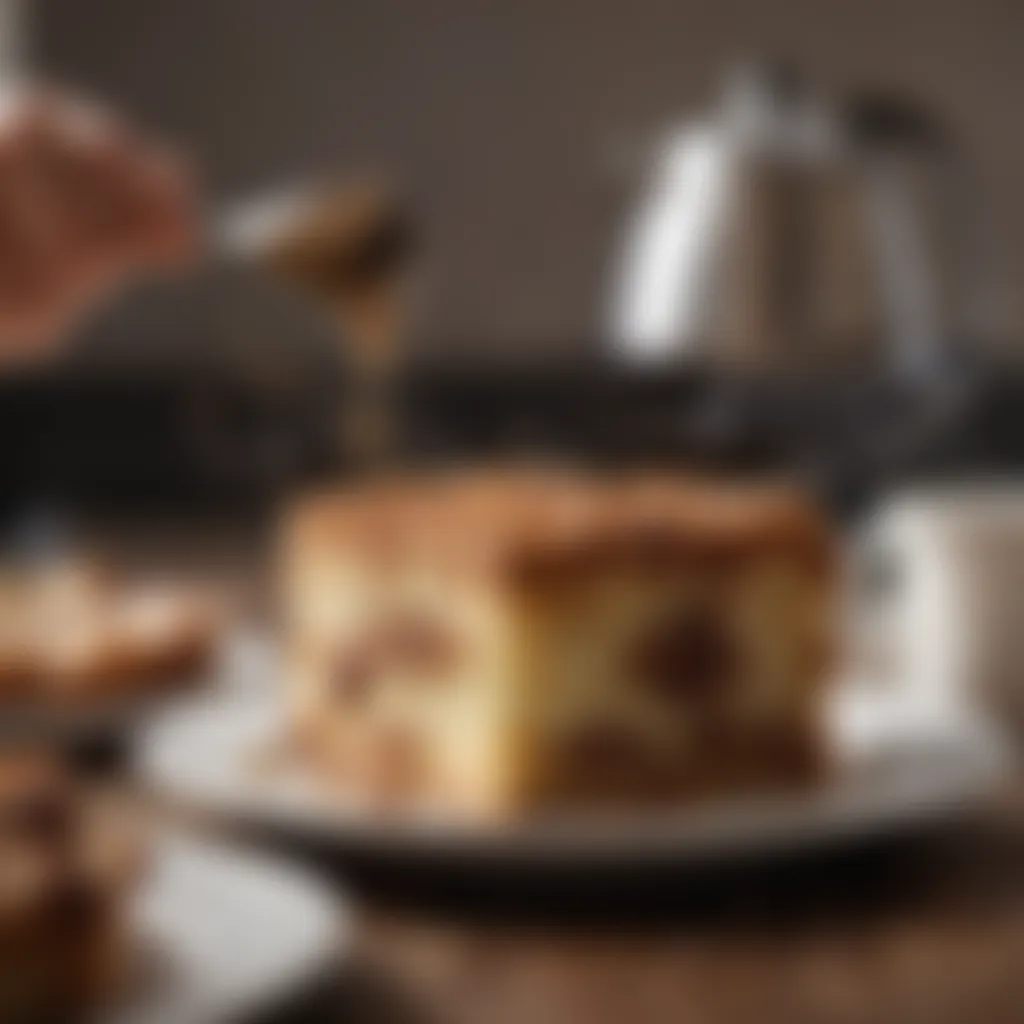

Choosing the Right Fillings
When it comes to fillings, the options can be quite diverse, and the right choice can elevate your coffee cake from good to extraordinary.
Creamy Layers
Creamy layers can be a game changer, introducing richness and moisture to coffee cakes. Commonly made with cream cheese or ricotta, these layers create a luxurious texture that contrasts beautifully with fluffy batter. This creamy element provides a key characteristic of additional depth; they don't just stay within the cake—they infuse the entire slice with a delightful pairing of flavors, often complemented by spices or extracts. This method is popular for those who crave a richer dessert, offering a unique way to surprise someone with a flavor they're not expecting. The potential downside is that adding too much can lead to a soggy cake; therefore, it's critical to strike that precise balance.
Fruit Compotes
Fruit compotes are a fabulous option for filling, providing bright flavors that can brighten the cake considerably. They are typically made by simmering fresh or frozen fruits with sugar and sometimes spices, creating a sweet and slightly tangy accompaniment. The standout feature of fruit compotes is their freshness, lending a vibrancy to the otherwise cozy coffee cake experience. They are versatile and can be made from a range of fruits, from classic berries to unusual tropical varieties, making them appealing to many. However, it's important to be mindful of moisture; if too much juice is added, it can turn the cake mushy. A well-balanced fruit compote can indeed elevate your cake, but it requires careful consideration.
"Toppings and fillings are not merely accents; they are crucial players in the game of taste and texture, making the final dish more than just a sum of its parts."
In summary, the careful selection of toppings and fillings can significantly influence the success of your coffee cake. Each choice—whether it be a crumbly finish or a creamy layer—must be made with an eye toward how it complements or enhances the cake itself. The artistry of coffee cake creation truly shines in these details, making them not to be overlooked.
Baking Methodology
When it comes to making a memorable coffee cake, the methodology of baking cannot be overlooked. It plays a crucial role in determining the final product's texture, flavor, and overall success. Each step in the baking process is intertwined, like the threads of a fine tapestry, contributing to the masterpiece that emerges from the oven. Understanding temperature control, baking time, and pan selection are essential for every home baker who wishes to elevate their coffee cake from ordinary to extraordinary.
Temperature and Bake Time
The intricacies of temperature and bake time are often underestimated. Baking a coffee cake at the correct temperature can be the difference between a delightful treat and a dry, crumbly disaster. Generally, coffee cakes are baked at a moderate temperature—typically around 350°F (175°C). This temperature allows for even baking, ensuring that the cake rises properly without scorching the top.
The bake time is equally significant; too short and you have a gooey center, too long and it may come out as dry as dust. Multiple factors can affect this timing, including the size and composition of the cake. An average coffee cake may take anywhere from 30 to 50 minutes, but it is wise to start checking a few minutes ahead of the suggested time. A toothpick poked in the center should come out clean or with just a few moist crumbs sticking to it, indicating that you have found the sweet spot.
Pan Selection
Pan selection is another aspect pivotal for crafting a beautiful coffee cake. The right pan can enhance the baking process and influence the finished cake's texture and presentation.
Sizes and Shapes
Choosing the right size and shape of the pan is vital. A traditional round 9-inch cake pan is a popular choice among bakers, thanks to its versatility and even heat distribution. However, rectangular pans, such as a 9x13 inch, provide a more casual serving option and are perfect for events where you might want to cut squares. Large bundt pans also add a touch of elegance with their intricate designs and can serve as a stunning centerpiece on any table.
The unique feature of these various sizes and shapes lies in their ability to influence the baking time. A deeper pan can slow down the baking process, while a shallower one tends to cook quicker. This means you must adjust your timing accordingly; if you go with a smaller, deeper pan, think about adding a few more minutes to your bake time.
Material Considerations
The material of your pan can make a difference too. Metallic pans, often made from aluminum or stainless steel, heat up quickly and yield well-baked results. These materials are beneficial for browning the cake effectively while ensuring that it doesn’t get stuck to the pan, assuming you have greased it correctly.
Alternatively, glass or silicone pans have their perks. A glass pan allows you to monitor the baking progress more easily, while silicone provides a non-stick advantage, though these may require slightly longer baking times due to their insulating properties. Ultimately, the key characteristic of your selected material should align with what you wish to achieve in your coffee cake—be it a nicely browned crust or a moist interior.
"In baking, the tools you use can be just as critical as the ingredients you select."
When it comes to crafting a show-stopping coffee cake, understanding baking methodology is essential. Temperature control, timing, and pan selection are the trinity of successful baking that every housewife should master. Take the time to learn and adapt these methodologies, and you will undoubtedly see an improvement in your coffee cake creations.
Cooling and Storing Procedures
Cooling and storing your coffee cake properly isn't just a matter of routine—it's crucial for preserving its texture, flavor, and overall quality. Once that cake has emerged from the oven, steaming and fragrant, handling it with care ensures that it maintains that just-baked goodness for as long as possible. Overlook this step, and you might end up with a delightful treat that’s damp or stale; alas, that's a situation nobody desires.
Benefits of Proper Cooling and Storage:
- Maintenance of texture and moisture.
- Enhancement of flavor as the cake settles.
- Reduction of the likelihood of mold growth through correct storage methods.
To truly enjoy your creation, adhering to the right cooling techniques is essential. There's a method to this cool-down madness, as you wouldn't want your warm cake to invest in a soggy future!
Cooling Techniques
Let’s dive into how to cool that golden-brown masterpiece of yours. Once you take the cake out of the oven, the first step is to let it sit in the pan for about 10 to 15 minutes. This resting time allows the cake to firm up slightly, which makes it easier to handle when you finally transfer it.
After that initial period, flip it onto a wire cooling rack. This is helpful because it promotes airflow, allowing the steam to escape. Keeping it in the pan for too long can create moisture build-up, leading to that dreaded sogginess. If you don’t have a wire cooling rack, an upside-down plate could do the trick, just make sure it’s sturdy!
It's important to ensure that the cake cools completely before any storage occurs, as warmth can lead to almost a steam oven effect within a container.
Optimal Storage Conditions
Short-Term Storage
When it comes to short-term storage, think of a simple, effective option: the airtight container. It’s often best to preserve your coffee cake for a few days on the counter at room temperature. Keeping it covered will prevent it from drying out and keep those flavors intact. You might consider wrapping it in plastic wrap or aluminum foil before placing it into the container.
This method allows the cake to stay moist while maintaining its texture—no one enjoys a dried-out bite. Moreover, storing it in this way makes it a go-to for quick snacking or impromptu coffee dates. However, just a heads up: this approach works best for cakes without heavy frostings or fillings, as those might not fare as well at room temperature.
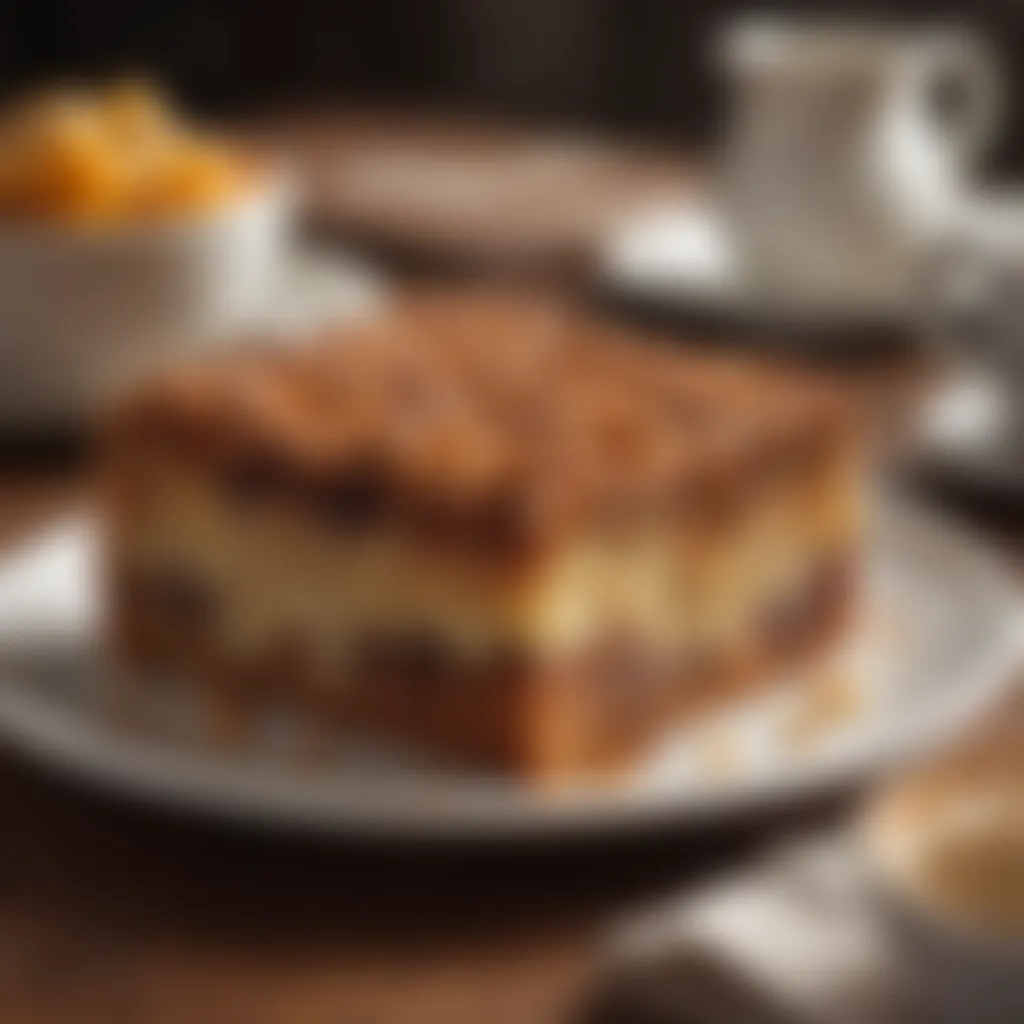
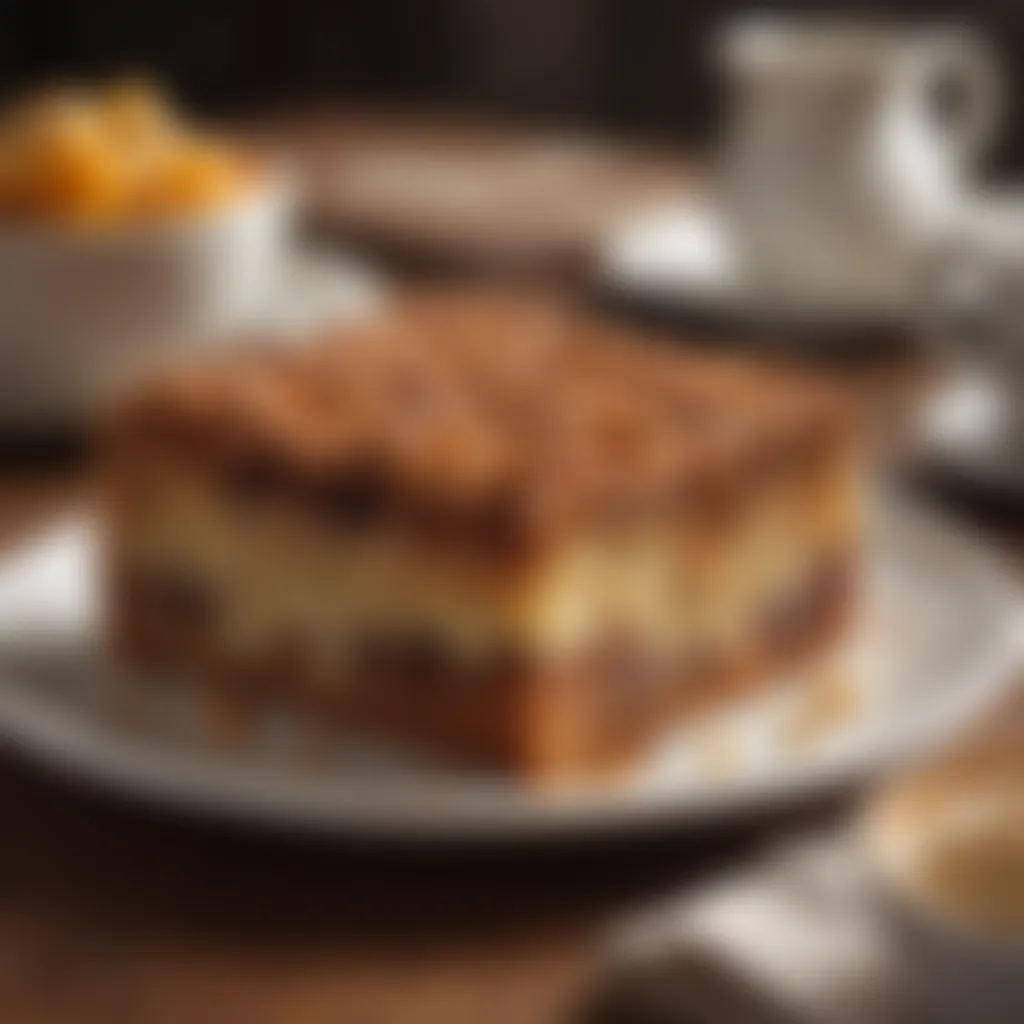
Long-Term Preservation
For long-term preservation, freezing is the name of the game. If you find yourself with leftover cake or simply want to get ahead of the baking game, this method is truly beneficial. By wrapping the cooled coffee cake tightly in plastic wrap and following up with aluminum foil, you’ll help to keep out excess air, ensuring that it remains intact for up to three months.
One unique feature of freezing? It doesn't alter the flavor much if you handle the wrapping correctly. You can defrost your cake at room temperature for a few hours, or gently in the microwave on a low setting. Just bear in mind that the texture may differ slightly after thawing; still, it’s often a small price to pay for indulging in homemade goodness at a later date.
In summary, your coffee cake deserves the very best, whether served fresh from the oven or enjoyed later on. By minding these cooling and storing procedures, you can savor that wonderful flavor for days to come.
Presentation and Serving Suggestions
When it comes to coffee cake, how it looks can be just as important as how it tastes. Presentation not only enhances the eating experience but also showcases the effort that went into making it. The way you present your coffee cake can transform a simple treat into a centerpiece that draws attention, sparking conversations and appetites alike. From the decorative choices of plate arrangements to the thoughtful pairing of beverages, every detail counts.
One major benefit of impressive presentation is that it elevates the perception of the homemade cake. An eye-catching arrangement might lead guests to assume that they’re indulging in a dish from a high-end café instead of someone’s kitchen. This can be particularly rewarding if you’re serving alongside friends or family during a casual gathering.
Also, paying attention to how you serve coffee cake can significantly affect its flavor experience. Each element of presentation, from garnishes to pairings, can complement and highlight the cake’s unique flavors, leading to a richer tasting experience overall.
Plate Arrangement
When arranging your coffee cake on a plate, think about color contrasts and texture variations. For instance, a light-colored coffee cake looks great on a darker plate, providing a visual pop. Don’t hesitate to add a flourish at the side with fresh fruit or a drizzle of glaze.
Here are some tips for plate arrangement:
- Use a cake stand to elevate the cake and create an inviting focal point.
- Place vibrant berries or sprigs of mint around the cake for a fresh touch.
- Consider layering: put individual slices in a staggered format instead of in a line.
- A dusting of powdered sugar can give a finishing touch, adding elegance without overpowering.
Moreover, it might be worthwhile to experiment with different plating styles. Vertical stacking can be visually appealing, while a simple slice accompanied by a dollop of whipped cream offers a classic touch. Remember, creativity in your presentation can lead to a memorable experience for your guests.
Pairing with Beverages
Coffees
Coffee is the quintessential pairing for coffee cake. The combination is classic; they complement each other perfectly. The rich, bold flavors of coffee tend to harmonize with the sweetness of cake. A well-brewed cup of coffee enhances the overall experience, drawing out nuances in both the drink and dessert.
A key characteristic of coffee is its bitterness, which balances the sugar in coffee cake. This dynamic makes coffee not just a drink but an integral part of the enjoyment process. For example, a medium roast with chocolate notes works beautifully with cinnamon-flavored coffee cake, offering a taste experience that sings.
One unique feature of coffee is its versatility. Whether you prefer a strong espresso or a lighter medium brew, there’s a coffee to match every coffee cake variation. However, the downside might be caffeine-sensitive individuals who would prefer to skip much of that bite altogether.
Teas
Tea provides a refreshing alternative to coffee. It brings a different depth to the pairing dynamic. With a variety of flavors ranging from floral to earthy, tea can accentuate the flavors in coffee cake without overwhelming them.
A notable characteristic of tea is its subtlety. Unlike coffee, which can be robust and bold, many teas have a gentler profile, allowing the cake's flavors to shine. Green tea or a lightly brewed herbal tea can complement a lemon-infused coffee cake quite well, creating a layered tasting experience with refreshing undertones.
However, unlike coffee, some might find tea a bit too weak if they’re used to stronger beverages. It’s essential to consider the preferences of those you are serving to create a balance that suits everyone.
Experimentation and Adaptation
In the realm of baking, experimentation and adaptation is what separates the average from the extraordinary. When it comes to coffee cakes, this concept takes on an even more significant role. By venturing beyond traditional recipes and common ingredients, bakers can create truly unique flavors and textures. Don’t be afraid to shake things up – creative cooking allows for personal touches that can turn a good coffee cake into a great one.
The art of experimentation is about finding what works best for your palate. For instance, if a recipe calls for regular all-purpose flour, consider substituting with whole wheat flour or even almond flour to give your cake a distinctive nutty flavor. Using different sweeteners like honey or maple syrup instead of traditional sugar can lead to a sweeter yet less processed taste, while also introducing an exciting new dimension to your baked good.
Innovative Ingredient Substitutions
Trying out alternative ingredients is one of the most effective ways to infuse your coffee cake with a new character. For example, many bakers are turning to Greek yogurt as a substitute for oil or butter in cake recipes, yielding a moist texture while slashing the fat content. This substitution not only keeps health in mind but also adds a subtle tanginess that complements the sweetness of the cake.
Another great swap is using mashed bananas or applesauce in place of sugar or butter. The natural sweetness and moisture from these fruits can elevate the flavor, while making the cake a bit healthier.
Here's a brief overview of several innovative substitutions you might consider:
- Flour Options: Almond flour or coconut flour for nuttiness.
- Sweeteners: Honey or maple syrup for a unique flavor profile.
- Fats: Avocado for a buttery texture without the saturated fat.
- **Liquid:**Nut milks like almond or cashew for added flavor.
These swaps not only cater to dietary constraints but also open up delightful possibilities for flavor exploration.
Creating Unique Flavor Combinations
The magic of a coffee cake often lies in its flavor combinations. Think beyond the basic vanilla or chocolate; this is where your creativity can blossom. Add zest from citrus fruits like lemon or orange to elevate the sweetness while providing refreshing notes. You can also mix in spices like cardamom, nutmeg, or ginger to not just flavor, but also to evoke warm, inviting memories that make coffee time feel special.
Consider this: mixing chocolate chips with crushed hazelnuts can produce a rich, nutty flavor in your cake, giving you a delicious treat that feels decadent yet familiar. Dried fruits like cranberries or apricots can add chewy texture and burst of flavor, brightening a standard recipe and making it your own.[^1]
Here are some inspiration for flavor combinations:
- Coffee and Nutmeg: A warm aromatic kick.
- Chocolate and Orange: A classic flavorful pair.
- Vanilla and Almond: Creamy yet nutty.
- Cinnamon and Walnut: Great for a cozy feel.
Be bold; don’t shy away from mixing and matching! Every attempt is a lesson in what works best for your taste buds, and before you know it, you’ll have a signature coffee cake that resonates with those who take a bite.
"Cooking is like love. It should be entered into with abandon or not at all." - Julia Child
By experimenting and adapting, you not only expand your skills but also craft a narrative of flavors in your kitchen that is uniquely yours. The journey of creating a coffee cake is a personal one, a reflection of your preferences and a canvas for culinary innovation. Let your imagination guide your baking, and you’ll end up with a coffee cake that doesn’t just fill the plate, but also fills hearts with joy.
[^1]: For more adventurous combinations, check platforms like reddit.com and facebook.com for sharing and discussing recipes.







